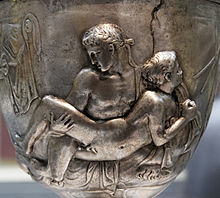

In ancient Greece and Rome, a catamite (Latin: catamītus) was a pubescent boy who was the intimate companion of an older male, usually in a pederastic relationship.[1] It was generally a term of affection and literally means "Ganymede" in Latin, but it was also used as a term of insult when directed toward a grown man.[2] The word derives from the proper noun Catamitus, the Latinized form of Ganymede, the name of the beautiful Trojan youth abducted by Zeus to be his companion and cupbearer, according to Greek mythology.[3] The Etruscan form of the name was Catmite, from an alternative Greek form of the name, Gadymedes.[4]
In its modern usage, the term catamite refers to a boy as the passive or receiving partner in anal intercourse with a man.[5]
- ^ Craig Williams, Roman Homosexuality (Oxford University Press, 1999, 2010), pp. 52–55, 75.
- ^ Cite error: The named reference
Cicero p. 95was invoked but never defined (see the help page). - ^ Alastair J. L. Blanshard, "Greek Love," in Sex: Vice and Love from Antiquity to Modernity (Wiley-Blackwell, 2010), p. 131. Both Servius, note to Aeneid 1.128, and Festus state clearly that Catamitus was the Latin equivalent of Ganymedes; Festus says he was the concubinus of Jove. Alessandra Bertocchi and Mirka Maraldi, "Menaechmus quidam: Indefinites and Proper Nouns in Classical and Late Latin," in Latin vulgaire–Latin tardif. Actes du VIIème Colloque international sur le latin vulgaire et tardif. Séville, 2–6 septembre 2003 (University of Seville, 2006), p. 95, note 16.
- ^ Larissa Bonfante and Judith Swaddling, Etruscan Myths (University of Texas Press, 2006), p. 73.
- ^ Oxford English Dictionary 3rd Ed. (2003)